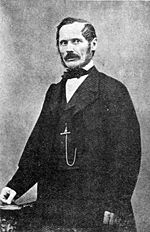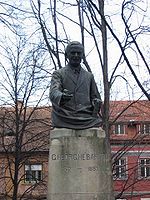
George Barit
Encyclopedia

Romania
Romania is a country located at the crossroads of Central and Southeastern Europe, on the Lower Danube, within and outside the Carpathian arch, bordering on the Black Sea...
n historian, philologist, playwright, politician, businessman and journalist, the founder of the Romanian language
Romanian language
Romanian Romanian Romanian (or Daco-Romanian; obsolete spellings Rumanian, Roumanian; self-designation: română, limba română ("the Romanian language") or românește (lit. "in Romanian") is a Romance language spoken by around 24 to 28 million people, primarily in Romania and Moldova...
press in Transylvania
Transylvania
Transylvania is a historical region in the central part of Romania. Bounded on the east and south by the Carpathian mountain range, historical Transylvania extended in the west to the Apuseni Mountains; however, the term sometimes encompasses not only Transylvania proper, but also the historical...
.
Biography
Born in Jucu de Jos, JucuJucu
Jucu is a commune in Cluj County, Romania. It is composed of five villages: Gădălin , Juc-Herghelie , Jucu de Mijloc , commune centre Jucu de Sus and Vişea .-Economy:...
, Cluj County
Cluj County
Cluj ; is a county of Romania, in Transylvania, with the capital city at Cluj-Napoca.-Demographics:In 2007, it had a population of 692,316 and a population density of 104/km².*Romanians – 80%*Hungarians – 17.5%*Roma – 2.5%-Geography:...
, he was the son of the Greek-Catholic
Romanian Church United with Rome, Greek-Catholic
The Romanian Church United with Rome, Greek-Catholic is an Eastern Catholic Church which is in full union with the Roman Catholic Church. It is ranked as a Major Archiepiscopal Church and uses the Byzantine liturgical rite in the Romanian language....
priest Ioan Pop Bariţ, and of Ana Rafila. He attended school in Trascău (today Remetea, Alba County
Alba County
Alba is a county of Romania, in Transylvania, its capital city being Alba-Iulia with a population of 66,406.- Demographics :In 2002, it had a population of 382,747 and the population density was 61/km².* Romanians - 90.4%* Hungarians - 5.4%...
), and then highschool in Blaj
Blaj
Blaj is a city in Alba County, Transylvania, Romania. It has a population of 20,758 inhabitants.The landmark of the city is the fact that it was the principal religious and cultural center of the Romanian Greek-Catholic Church in Transylvania....
and Cluj
Cluj-Napoca
Cluj-Napoca , commonly known as Cluj, is the fourth most populous city in Romania and the seat of Cluj County in the northwestern part of the country. Geographically, it is roughly equidistant from Bucharest , Budapest and Belgrade...
. Originally trained for priesthood, he decided instead to become a teacher at the Romanian language commercial school in Braşov
Brasov
Brașov is a city in Romania and the capital of Brașov County.According to the last Romanian census, from 2002, there were 284,596 people living within the city of Brașov, making it the 8th most populated city in Romania....
.

Brasov
Brașov is a city in Romania and the capital of Brașov County.According to the last Romanian census, from 2002, there were 284,596 people living within the city of Brașov, making it the 8th most populated city in Romania....
the first Romanian newspaper in his native region, and named it Gazeta de Transilvania
Gazeta de Transilvania
Gazeta de Transilvania was the first Romanian-language newspaper to be published in Transylvania. It was founded by George Bariţ in 1838 in Braşov...
. Politically active, he was an important personality in the revolution of 1848 in Transylvania, establishing connections with Romanian nationalists
Romantic nationalism
Romantic nationalism is the form of nationalism in which the state derives its political legitimacy as an organic consequence of the unity of those it governs...
and radicals
Radicalism (historical)
The term Radical was used during the late 18th century for proponents of the Radical Movement. It later became a general pejorative term for those favoring or seeking political reforms which include dramatic changes to the social order...
in Wallachia
Wallachia
Wallachia or Walachia is a historical and geographical region of Romania. It is situated north of the Danube and south of the Southern Carpathians...
and Moldavia
Moldavia
Moldavia is a geographic and historical region and former principality in Eastern Europe, corresponding to the territory between the Eastern Carpathians and the Dniester river...
, and using Gazeta as one of the main political voices demanding equal rights for Romanians
Romanians
The Romanians are an ethnic group native to Romania, who speak Romanian; they are the majority inhabitants of Romania....
and Transylvanian Hungarians after the Hungarian
Hungary
Hungary , officially the Republic of Hungary , is a landlocked country in Central Europe. It is situated in the Carpathian Basin and is bordered by Slovakia to the north, Ukraine and Romania to the east, Serbia and Croatia to the south, Slovenia to the southwest and Austria to the west. The...
nationalist revolutionary government began pressing for Transylvania to be removed from direct Austrian
Austrian Empire
The Austrian Empire was a modern era successor empire, which was centered on what is today's Austria and which officially lasted from 1804 to 1867. It was followed by the Empire of Austria-Hungary, whose proclamation was a diplomatic move that elevated Hungary's status within the Austrian Empire...
supervision.
After the revolutionary episode, in the period between the creation of an Austrian military government for the region and the Ausgleich
Ausgleich
The Austro-Hungarian Compromise of 1867 established the dual monarchy of Austria-Hungary. The Compromise re-established the sovereignty of the Kingdom of Hungary, separate from and no longer subject to the Austrian Empire...
, Bariţ returned to cultural and business activities. In 1861, alongside Andrei Şaguna
Andrei Saguna
Andrei Şaguna was a Metropolitan bishop of the Romanian Orthodox Church in Transylvania, and one of the Romanian community political leaders in the Habsburg Monarchy, especially active during the 1848 Revolution...
, Timotei Cipariu
Timotei Cipariu
Timotei Cipariu was a Romanian cleric and academic. He was one of the founding members of the Romanian Academy.- References :...
, he founded Asociaţia Transilvană pentru Literatura Română şi Cultura Poporului Român (ASTRA). He was its first secretary, and subsequently became its president.
Between 1852-1872 Bariţ was the Commercial Director of one of the first manufacturing companies in Transylvania with Romanian private capital, the Fabrica de hârtie din Zărneşti (Pulp and paper factory in Zărneşti, located west of Braşov in central Romania). During the 1870s he also acted as an adviser to the Founder and the Board of Administration of the Banca Albina, the first bank with private Romanian capital in Transylvania.
As a result of the first free elections in Transylvania in the spring of 1863, following Austria's introduction by imperial decree of representative democracy in its territory in 1861, Bariţ became a Member of Parliament in the Dieta Transilvaniei (Transylvanian Parliament) where the ethnic Romanians formed the majority. After 1863, he participated as one of the twenty-six official parliamentary delegates of the Transylvanian Parliament in the second (1863–1864) and third (1864–1865) parliamentary sessions of the central Austrian Parliament (Reichsrat, now National Council of Austria
National Council of Austria
The National Council is one of the two houses of the Austrian parliament. According to the constitution, the National Council and the complementary Federal Council are peers...
) in Vienna. There, as a full Member of Parliament, a full Member of the Finance Committee and a full Member of the Committee for the Transylvanian Railway, he held several speeches on the imperial financial and trade policies, on foreign policy, on central policies of the government in Vienna towards the Romanian Church United with Rome, and promoted reforms of public finance in Transylvania, as well as specific local interests of Transylvania within the Austrian empire. After mid-1865 he did not continue to go to other sessions of the central Parliament in Vienna, since the political effects of the Ausgleich moved Transylvanian central representation from Vienna to Budapest.
In December 1866, following the beginnings of the Ausgleich, Bariţ initiated and drafted together with Dr. Ioan Raţiu (1828–1902), the first Memorandum of the Romanians of Transylvania, addressed directly to emperor Franz Josef I of Austria and signed by 1,493 Transylvanian intellectuals, asking for the maintenance of the administrative and political autonomy of Transylvania within the Austrian empire and within Austrian supervision. This Memorandum was submitted to the emperor in December 1866 and is a precursor of a second memorandum, the Transylvanian Memorandum
Transylvanian Memorandum
The Transylvanian Memorandum was a petition sent in 1892 by the leaders of the Romanians of Transylvania to the Austro-Hungarian Emperor-King Franz Joseph, asking for equal ethnic rights with the Hungarians, and demanding an end to persecutions and Magyarization attempts.-Status:After the Ausgleich...
, submitted in 1892.
Between 1884 and 1888, Bariţ served as president of the Romanian National Party in Transylvania and Banat
Romanian National Party
The Romanian National Party , initially known as the Romanian National Party in Transylvania and Banat , was a political party which was initially designed to offer ethnic representation to Romanians in the Kingdom of Hungary, the Transleithanian half of Austria-Hungary, and especially to those in...
.
When ASTRA began publishing the review Transilvania, Bariţ was the main person involved in its editorial ventures, and became one of the authors of the very first Romanian-language Encyclopaedia (published in Sibiu
Sibiu
Sibiu is a city in Transylvania, Romania with a population of 154,548. Located some 282 km north-west of Bucharest, the city straddles the Cibin River, a tributary of the river Olt...
after his death, between 1898 and 1904). His main personal work, published between 1889 and 1891, was Părţi alese din Istoria Transilvaniei pre două sute de ani în urmă ("Selected Episodes of the Past Two Hundred Years in Transylvania's History").
Bariţ was a founding member of the Societatea Literară Română (1866), a precursor to the Romanian Academy
Romanian Academy
The Romanian Academy is a cultural forum founded in Bucharest, Romania, in 1866. It covers the scientific, artistic and literary domains. The academy has 181 acting members who are elected for life....
. Of the latter he was elected in 1868 its head of the historical section, its vice-president in 1876 and its president in 1893. He died in Sibiu a couple of months after his election and is buried in the graveyard of the "Biserica dintre Brazi" church in Sibiu, along with other major Romanian Transylvanian leaders.
Works
- Cuvântare scolasticească la ecsamenul de vară în Şcoala românească din Braşov şi Cetate, 1837
- Deutsch-Rumänisches Wörterbuch, Dicţionariu român-german, 1853–1854
- Dicţionariu românesc-unguresc, Magyar-román szótar, 1869
- Părţi alese din istoria Transilvaniei pre două sute de ani în urmă, I-III, Sibiu, 1889–1891
- Două drame familare, drama, 1891

